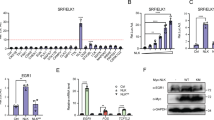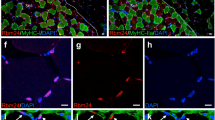Abstract
Gene expression in skeletal muscle is regulated by the firing pattern of motor neurons, but the signalling systems involved in excitation–transcription coupling are unknown. Here, using in vivo transfection in regenerating muscle, we show that constitutively active Ras and a Ras mutant that selectively activates the MAPK(ERK) pathway are able to mimic the effects of slow motor neurons on expression of myosin genes. Conversely, the effect of slow motor neurons is inhibited by a dominant-negative Ras mutant. MAPK(ERK) activity is increased by innervation and by low-frequency electrical stimulation. These results indicate that Ras–MAPK signalling is involved in promoting nerve-activity-dependent differentiation of slow muscle fibres in vivo.
This is a preview of subscription content, access via your institution
Access options
Subscribe to this journal
Receive 12 print issues and online access
$209.00 per year
only $17.42 per issue
Buy this article
- Purchase on Springer Link
- Instant access to full article PDF
Prices may be subject to local taxes which are calculated during checkout






Similar content being viewed by others
References
Duclert, A. & Changeux, J. P. Acetylcholine receptor gene expression at the developing neuromuscular junction. Physiol. Rev. 75, 339–368 (1995).
Eftimie, R., Brenner, H. R. & Buonanno, A. Myogenin and MyoD join a family of skeletal muscle genes regulated by electrical activity. Proc. Natl Acad. Sci. USA 88, 1349–1353 (1991).
Klarsfeld, A. et al. Regulation of muscle AChR α subunit gene expression by electrical activity: involvement of protein kinase C and Ca2+. Neuron 2, 1229–1236 (1989).
Huang, C. F., Tong, J. & Schmidt, J. Protein kinase C couples membrane excitation to acetylcholine receptor gene inactivation in chick skeletal muscle. Neuron 9, 671–678 (1992).
Chahine, K. G., Baracchini, E. & Goldman, D. Coupling muscle electrical activity to gene expression via a cAMP-dependent second messenger system. J. Biol. Chem. 268, 2893–2898 (1993).
Hughes, S. M. et al. Selective accumulation of MyoD and myogenin in fast and slow adult skeletal muscle is controlled by innervation and hormones. Development 118, 1137–1147 (1993).
Voytik, S. L., Przyborski, M., Badylak, S. F. & Konieczny, S. Differential expression of muscle regulatory factor genes in normal and denervated adult rat hindlimb muscles. Dev. Dyn. 98, 214–224 (1993).
Hughes, S., Chi, M., Lowry, O. & Gundersen, K. Myogenin induces a shift of enzyme activity from glycolytic to oxidative metabolism in muscles of transgenic mice. J. Cell Biol. 145, 633–642 (1999).
Chin, E. et al. A calcineurin-dependent transcriptional pathway controls skeletal muscle fibre type. Genes Dev. 12, 2499–2509 (1998).
Naya, R. J. et al. Stimulation of slow skeletal muscle fiber gene expression by calcineurin in vivo. J. Biol. Chem. 275, 4545–4548 (2000).
Calvo, S., Venepally, P., Cheng, J. & Buonanno, A. Fibre-type-specific transcription of the troponin I slow gene is regulated by multiple elements. Mol. Cell. Biol. 19, 515–525 (1999).
Semsarian, C. et al. Skeletal muscle hypertrophy is mediated by a Ca2+-dependent calcineurin signalling pathway. Nature 400, 576–581 (1999).
Goodyear, L. J., Chung, P.-Y., Sherwood, D., Dufresne, S. D. & Moller, D. E. Effects of exercise and insulin on mitogen-activated protein kinase signalling pathways in rat skeletal muscle. Am. J. Physiol. 271, E403–E408 (1996).
Aronson, D. et al. Exercise stimulates the mitogen-activated protein kinase pathway in human skeletal muscle. J. Clin. Invest. 99, 1251–1257 (1997).
Widegren, U. et al. Divergent effects of exercise on metabolic and mitogenic signalling pathways in human skeletal muscle. FASEB J. 12, 1379–1389 (1998).
Aronson, D., Dufresne, S. D. & Goodyear, L. J. Contractile activity stimulates the c-Jun NH2-terminal kinase pathway in rat skeletal muscle. J. Biol. Chem. 272, 25636–25640 (1997).
Sherwood, D. et al. Differential regulation of MAP kinase, p70(S6K), and Akt by contraction and insulin in rat skeletal muscle. Am. J. Physiol. 276, E870–E878 (1999).
Esser, K., Gunning, P. & Hardeman, E. Nerve-dependent and -independent patterns of mRNA expression in regenerating skeletal muscle. Dev. Biol. 159, 173–183 (1993).
Vitadello, M., Schiaffino, M. V., Picard, A., Scarpa, M. & Schiaffino, S. Gene transfer in regenerating muscle. Hum. Gene Ther. 5, 11–18 (1994).
Schiaffino, S. & Reggiani, C. Molecular diversity of myofibrillar proteins: gene regulation and functional significance. Physiol. Rev. 76, 371–423 (1996).
Jerkovic, R., Argentini, C., Serrano-Sanchez, A., Cordonnier, C. & Schiaffino, S. Early myosin switching induced by nerve activity in regenerating slow skeletal muscle. Cell Struct. Funct. 22, 147–153 (1997).
White, M. et al. Multiple Ras functions can contribute to mammalian cell transformation. Cell 80, 533–541 (1995).
Joneson, T., White, M., Wigler, M. & Bar-Sagi, D. Stimulation of membrane ruffling and MAP kinase activation by distinct effectors of RAS. Science 271, 810–812 (1996).
Rodriguez-Viciana, P. et al. Role of phosphoinositide 3-OH kinase in cell transformation and control of the actin cytoskeleton by Ras. Cell 89, 457–467 (1997).
Jerkovic, R., Vitadello, M., Kelly, R., Buckingham, M. & Schiaffino, S. Fibre type-specific and nerve-dependent regulation of myosin light chain 1 slow promoter in regenerating muscle. J. Muscle Res. Cell Motil. 18, 369–373 (1997).
Wolff, J. A. et al. Direct gene transfer into mouse muscle in vivo. Science 247, 1465–1468 (1990).
Devlin, B. H., Wefald, F. C., Kraus, W. E., Bernard, T. S. & Williams, R. S. Identification of a muscle-specific enhancer within the 5"-flanking region of the human myoglobin gene. J. Biol. Chem. 264, 13896–13901 (1989).
Hennig, R. & Lømo, T. Firing patterns of motor units in normal rats. Nature 314, 164–166 (1985).
Ausoni, S., Gorza, L., Schiaffino, S., Gundersen, K. & Lømo, T. Expression of myosin heavy chain isoforms in stimulated fast and slow rat muscles. J. Neurosci. 10, 153–160 (1990).
Olson, E. N., Spizz, G. & Tainski, M. A. The oncogenic forms of N-ras and H-ras prevent skeletal myoblast differentiation. Mol. Cell. Biol. 7, 2104–2111 (1987).
Bennet, A. M. & Tonks, N. K. Regulation of distinct stages of skeletal muscle differentiation by mitogen-activated protein kinases. Science 278, 1288–1291 (1997).
Gredinger, E., Gerber, A. N., Tamir, Y., Tapscott, S. J. & Bengal, E. Mitogen-activated protein kinase pathway is involved in the differentiation of muscle cells. J. Biol. Chem. 273, 10436–10444 (1998).
Feldman, J. L. & Stockdale, F. E. Skeletal muscle satellite cell diversity: satellite cells form fibres of different types in cell culture. Dev. Biol. 143, 320–334 (1991).
Dusterhoft, S. & Pette, D. Satellite cells from slow rat muscle express slow myosin under appropriate culture conditions. Differentiation 53, 25–33 (1993).
Barjot, C., Cotten, M.-L., Goblet, C., Whalen, R. G. & Bacou, F. Expression of myosin heavy chain and of myogenic regulatory factor genes in fast or slow rabbit muscle satellite cell cultures. J. Muscle Res. Cell Motil. 16, 619–628 (1995).
Rosenblatt, J., Parry, D. & Partridge, T. Phenotype of adult mouse muscle myoblasts reflects their fibre type of origin. Differentiation 60, 39–45 (1996).
DiMario, J. X., & Stockdale, F. E. Both myoblast lineage and innervation determine fiber type and are required for expression of the slow myosin heavy chain 2 gene. Dev. Biol. 188, 167–180 (1997).
Finkbeiner, S. & Greenberg, M. E. Ca2+-dependent routes to Ras: mechanisms for neuronal survival, differentiation, and plasticity? Neuron 16, 233–236 (1996).
Gu, X. & Spitzer, N. C. Distinct aspects of neuronal differentiation encoded by frequency of spontaneous Ca2+ transients. Nature 375, 784–787 (1995).
Dolmetsch, R., Lewis, R. S., Goodnow, C. C. & Healy, J. I. Differential activation of transcription factors induced by Ca2+ response amplitude and duration. Nature 386, 855–858 (1997).
Fields, R. D., Eshete, F., Stevens, B. & Itoh, K. Action potential-dependent regulation of gene expression: temporal specificity in Ca2+, cAMP-responsive element binding proteins, and mitogen-activated protein kinase signalling. J. Neurosci. 17, 7252–7266 (1997).
Ramocki, M. B. et al. Signalling through mitogen-activated protein kinase and Rac/Rho does not duplicate the effects of activated Ras on skeletal myogenesis. Mol. Cell. Biol. 17, 3547–3555 (1997).
Hasegawa, K., Lee, S. J., Jobe, S. M., Markham, B. E. & Kitsis, R. N. Cis-acting sequences that mediate induction of beta-myosin heavy chain gene expression during left ventricular hypertrophy due to aortic constriction. Circulation 96, 3943–3953 (1997).
Crespo, P. et al. Signalling through transforming G protein-coupled receptors in NIH 3T3 cells involves c-Raf activation. Evidence for a protein kinase C-independent pathway. J. Biol. Chem. 269, 21103–21109 (1994).
Schiaffino, S. et al. Three myosin heavy chain isoforms in type 2 skeletal muscle fibres. J. Muscle Res. Cell Motil. 10, 197–205 (1989).
De Nardi, C. et al. Type 2X myosin heavy chain is coded by a muscle fibre type-specific and developmentally regulated gene. J. Cell Biol. 123, 823–835 (1993).
Acknowledgements
This work was supported by grants from the European Commission (BIOTECH contract number ERBBIO4CT960216), the Giovanni Armenise–Harvard Foundation for Advanced Scientific Research, Telethon-Italy, the Italian Space Agency (ASI) and the Italian Ministry of University and Scientific and Technological Research (MURST). A.L.S. is a TMR Marie Curie research training grant recipient. We thank A. Hall, E. Taparowski and S. Alemà for Ras mutants; J.S. Gutkind for HA–ERK; R. Kitsis for MyHC-slow promoter-luciferase; R.S. Williams for myoglobin–luciferase; T. Pozzan, P.P. di Fiore and G. Scita for discussions; and A. Picard for help with some experiments.
Correspondence and requests for materials should be addressed to S.S.
Author information
Authors and Affiliations
Corresponding author
Rights and permissions
About this article
Cite this article
Murgia, M., Serrano, A., Calabria, E. et al. Ras is involved in nerve-activity-dependent regulation of muscle genes. Nat Cell Biol 2, 142–147 (2000). https://doi.org/10.1038/35004013
Received:
Revised:
Accepted:
Published:
Issue Date:
DOI: https://doi.org/10.1038/35004013
This article is cited by
-
Cognitive Dysfunction and Exercise: From Epigenetic to Genetic Molecular Mechanisms
Molecular Neurobiology (2024)
-
MiRNA sequencing of Embryonic Myogenesis in Chengkou Mountain Chicken
BMC Genomics (2022)
-
The myokine Fibcd1 is an endogenous determinant of myofiber size and mitigates cancer-induced myofiber atrophy
Nature Communications (2022)
-
The role of the neural stimulus in regulating skeletal muscle hypertrophy
European Journal of Applied Physiology (2022)
-
Mechanisms of muscle atrophy and hypertrophy: implications in health and disease
Nature Communications (2021)



